Mexico’s Valle de Guadalupe wine region continues to gain international prominence. The Valle has been referred to as the Napa Valley of Mexico, and for a good reason. This emerging region can yield world-class wines, blessed with a perfect climate, a centuries-old winemaking tradition, and surrounded by two seas.
Until the 1990s, the Valle’s wine production was confined to a few major producers who bought grapes from small farmers and mass-produced commercial wines. However, the area is experiencing a rebirth with renewed interest in its potential due to stunning vistas, designer hotels, and impeccable Mexican cuisine. Yet, the wine alone will keep you returning to this ever-growing destination.
Today, over 120 wineries in the region boast a diverse array of wines, including sparkling wines, atypical blends, and grapes that thrive—perhaps surprisingly—in Mexico’s climate, such as Nebbiolo.
Perhaps even more remarkable than the excellent wines coming out of the Valle de Guadalupe is the number of women producing them. The influence of women on Mexico's wine industry is profound, and some of Mexico's most exciting and coveted wines are being produced by a cadre of women winemakers.
I had the opportunity to connect with a few of these influential women during a recent trip to the charming area. Below is an introduction to (some of) the ladies advancing Mexico's wine industry: Kristin Schute, Fer Parra, Tru Miller, Violeta Jiménez, and Natalia Badan:
Meet Kristin Shute of Lechuza Vineyard:
Kristin Shute is the award-winning winemaker for family owned and operated Lechuza Vineyard. She is producing 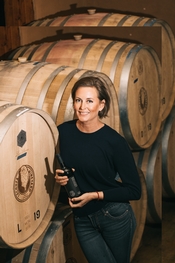 some of the most exciting wines coming out of the region.
some of the most exciting wines coming out of the region.
Miranda Franco (MF): “What path did you take to making wine?”
Kristin Schute (KS): “My path to wine was semi-unconventional. I stepped into our family’s hobby, turning it into a business. Previously, I worked on the other side of the industry, managing a wine-based restaurant in Santa Barbara. When my parents offered me this opportunity, I needed to learn every aspect from the beginning. My father was my main mentor, being a graduate from the UC Davis Wine Makers Abroad program. We also worked in conjunction with an established consultant from Argentina. The blend of the two educational backgrounds, working in a new country for each of us, provided a unique approach.”
MF: “How would you describe your wine to someone who hasn't experienced your wines yet? How does the unique nature of the Valle’s terroir impact your wine?”
KS: “Our brand consists of two different styles of winemaking. One of which is more classic with influences from classic winemaking regions. Our black line is traditionally monovarietal, with time in barrels. Our second line is a bit more contemporary with minimal intervention wines. This line tends to have a bit more wiggle room for exploring different fermentation techniques and finishes. We try to keep intervention as low as we can for these, including low sulfates, minimal acidity adjustments, and bottling the wines unfiltered. The terroir of the region is very prevalent in all of our wines. We have bold flavors that are a direct impact of climate change and low rainfall. The aromas of our wine are very recognizable to the impact of the growing conditions and soil types.”
MF: “Did you have to jockey for equality or recognition in the field?”
KS: “This region is home to a beautiful collection of winemakers from all over with very different approaches. As for being a woman, there are great leaders who have opened the doors for us newbies. Tru Miller, Eileen Gregory, and Natalia Badan have made great strides to help elevate our participation in this industry. There are also many other women that are leaders, making their own names, giving us all notoriety. Lulu Martínez, Verónica Santiago, Cristina Pino, and Laura Zamora have all brought significant attention to women's abilities in this region.”
MF: “Have you had any mentors along the way, either those in the industry or others, that inspired you to chart your path?”
KS: “Absolutely. In Santa Barbara, Doug Margerum and Greg Brewer were great winemakers that inspired me. Sebastian Suárez and Camilo Magoni have been great supporters for me here in the Valle.”
MF: “What are some of the most innovative ideas you’ve so far brought to the wine industry?”
KS: “I am consistently learning as we go. To be honest, I have only made wine nine times. With every harvest, I draw from my notes to try to increase my efficiency and enhance profiles from years past. One new wine taking this region by storm is a chilled, unoaked Nebbiolo. Very much a new concept but well received.”
MF: “Why should a wine enthusiast travel to the Valle de Guadalupe?”
KS: “The region is very open to new concepts and approaches. I appreciate the differences in wines and experiences. Often wine countries can feel monochromatic; here is very much the opposite. Additionally, the hospitality in this region is top-notch. There is space for everyone, novice to expert.”
MF: “What would we find if we were to take a dive into your personal wine collection?”
KS: A heavy impact of California wines, as that is where I am from originally. My collection also includes many experimental wines. Often, I tend to migrate to one-grape wines to further my knowledge of the grapes from other regions.
Meet Fer Parra of Pouya Wines: Fer Parra is a chemist turned winemaker who’s been making sparkling wine since 2018 and launched her own label, 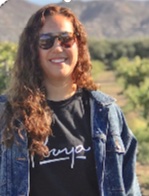 “Pouya,” in 2020.
“Pouya,” in 2020.
MF: What path did you take to making wine?
Fer Parra (FP): “I have a BS in biotech and worked in the industry for a decade, but then realized I needed a change, so I decided to follow my passion. I applied for a Master's in France, and it changed my whole life!”
MF: “How would you describe your wines to someone who hasn't experienced them yet? How does the unique nature of the Valle’s terroir impact your wines?”
FP: “I’d describe them as light, fresh, crisp, and very expressive wines. Most of the wines we make are loud, but in a good way, with a lot of acidity and aroma, but very rounded once you try them. We do low intervention wines, so the terroir is the wine. We work with different varieties from different microclimates, and we want each one to tell the story of the place and each harvest.”
MF: Did you have to jockey for equality or recognition in the field?
FP: “I came from ten years of working with male engineers, so I had a lot of practice fighting sexism. When I started in the wine industry, I got "lucky," by working for one of the legends in Baja, who he gave me the "male validation stamp," and I got respect because of who I worked for. Now that I am doing my own project, everyone knows that I can hold my own; plus, I came in a great time when other women had done the hard job of being the first females in the wine industry. But still, people get surprised when I tell them we are an all-female project; I'm like, ‘yeah, dude, girls can lift heavy stuff, drive a truck full of grapes, and fix equipment.’ Notably, most of the women in the wine industry in Mexico have degrees in winemaking (BS, MS) versus the males who most began in the industry by learning the trade. As in every other industry, we must be twice as smart and work twice as hard to even be considered.
MF: Have you had any mentors along the way, either those in the industry or others, that inspired you to chart your path?
FP: “Yes, I always say that my project Pouya is the culmination of all my professional and personal experiences; I believe that everyone I've interacted with has left a mark and led me to this path. Specially, through the negative experiences, I have learned what I don't want and who I don't want to be. I'm very grateful to have a family that has nurtured my "wild spirit," which has let me do things my way.”
MF: “What are some of the most innovative ideas you’ve so far brought to the wine industry?”
FP: “The wine industry has existed for thousands of years, so we are not coming up with anything new. However, I do like breaking the rules. Pouya is a very small company, and since we started, we have wanted to do our own thing. We are one of the first to do wine in bags, and we do untraditional sparkling wine (by the traditional method using a non-traditional grape like Grenache). We are also selling high acidity, low alcohol wines into a market where people thought that was impossible. We proved that we could do low-intervention wines and end up with healthy, non-funky wines. We've been busy, but it's been fun!”
MF: “Why should a wine enthusiast travel to Baja?”
FP: “We live in paradise! Great weather all year round, the best food, beautiful wine and beer, and the most impressive sights, what more could you want? I've lived in other places, beautiful places, however, I've always come back, and we have the best sunsets!”
MF: “What would we find if we were to take a dive into your personal wine collection?”
FP: “I stink at collecting anything I buy and drink, but currently, my wine cellar (boxes in the other room) is full of wine that my friends make, making me very proud! I have the coolest friends!”
Meet Tru Miller of Adobe Guadalupe: Tru is the owner of a stunning, hacienda-style boutique six-room inn and vineyard that has become one of the 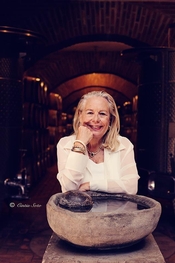 most iconic wine destinations in Mexico.
most iconic wine destinations in Mexico.
MF: “What path did you take to making wine?”
Tru Miller (TM): “I was 16, and my friends in High School and I tried the wines in the cellars of our parents. I really got into it, and the possibility of making wine became very important in my life.”
MF: “How would you describe your wine to someone who hasn't experienced your wines yet? How does the unique nature of the Valle's terroir impact your wine?”
TM: “Someone who has not experienced our wine will be surprised how easy it is to drink it and love it. The wines of our valley have a special color and taste.”
MF: Did you have to jockey for equality or recognition in the field?
TM: “No, not at all; equality is not a problem for women in this Valle.”
MF: “Have you had any mentors along the way, either those in the industry or others, that inspired you to chart your path?”
TM: “Yes, my mentors are the top winemakers of northern Mexico.”
MF: “What are some of the most innovative ideas you've so far brought to the wine industry?”
TM: “The blends are inspired by different wine regions in the world.”
MF: “Why should a wine enthusiast travel to the Valle de Guadalupe?”
TM: You must come to the Guadalupe Valley if you like beautiful weather, beautiful valleys with delicious wines, and great food.”
MF: “What would we find if we were to take a dive into your personal wine collection?”
TM: “In my personal wine collection, you can find bad, good, and fantastic wines.”
Meet Violeta Jiménez of Monema: Monema is a debut project by Jiménez. La Monema is the name of her family's properties in the Valle 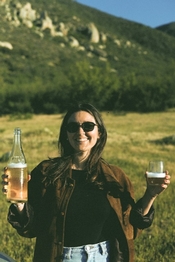 de Guadalupe – acquired in the early 60s from a woman named Monema who sold the property to her grandfather. Even though she left, the name stayed. The project consists of two wines: A delectable Petillant Naturel (or “Pét-nat”) made from very old Grenache vines and a small production Sauvignon Blanc – both from Valle de Guadalupe.
de Guadalupe – acquired in the early 60s from a woman named Monema who sold the property to her grandfather. Even though she left, the name stayed. The project consists of two wines: A delectable Petillant Naturel (or “Pét-nat”) made from very old Grenache vines and a small production Sauvignon Blanc – both from Valle de Guadalupe.
MF: “What path did you take to making wine?”
Violeta Jiménez (VJ): “My background is in architecture, but since I started architecture school, I started working in the hospitality industry with a touring company (Club Tengo Hambre) specializing in food and wine in Baja, California. I started my journey in the tasting rooms, and I was able to try the best wines of Valle de Guadalupe. I also made friends (the best of friends) with most of the winemakers that I visited. This eventually took me in all directions in winemaking.” I started off after being invited to help during harvest seasons in different vineyards, but curiosity always took me a step forward, and I quickly got involved in the vinification part in Cavas del Mogor. I immediately fell in love with all aspects of winemaking and with the community of the Valle de Guadalupe. A funny part of my relationship with Valle: My family has grown grapes for the past 50 years here, but I've never been a part of it or included in the business. I reintroduced myself to it 20 years later.
MF: “How would you describe your wine to someone who hasn't experienced your wines yet? How does the unique nature of the Valle’s terroir impact your wine?”
VJ: “I think both my labels are very much approachable to any palate. They are both very fresh and expressive wines. Before starting the project, I knew that I wanted to do something fun and delicious, so I went with grapes that I enjoyed in the Valle. I wanted to work with varieties that truly represent Valle de Guadalupe in terms of terroir. For me, it was a no-brainer to go all-in with Grenache. It's a grape that is very well adapted to our terroir and thrives in our climate, with its resulting lack of water.”
MF: “Did you have to jockey for equality or recognition in the field?”
VJ: “I feel that I am fortunate when it comes to equality and recognition in the field. Since I started my journey in the winemaking world, I have surrounded myself with female winemakers. I had many options before I began, and I immediately narrowed them to a place where I felt at home, and that was with my fellow female winemakers.”
MF: Have you had any mentors along the way, either those in the industry or others, that inspired you to chart your path?
VJ: “Definitely, Natalia Badan. She is largely responsible for me taking the leap into this beautiful side of life. Also, Fer Parra, my friend, and enologist.”
MF: “Why should a wine enthusiast travel to Baja?”
VJ: “Baja California is an oasis for anyone seeking amazing food, beer, wine, and great company. The shared spirit around the community is always very welcoming. We love making new friends and sharing our love for what we produce.”
MF: “What would we find if we were to take a dive into your personal wine collection?”
VJ: “All of the bubbles and many wines my friends make in Valle de Guadalupe. Also, currently, there are many gifts of natty wines from friends up in California.”
Meet Natalia Badan of El Mogor: Natalia Badan has spent her life on Rancho El Mogor, the vineyard and organic farm her Swiss-French parents built nearly 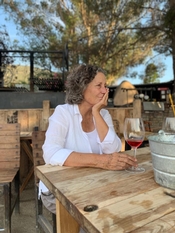 seven decades ago. This small-scale, family-run winery carefully crafts each vintage by hand.
seven decades ago. This small-scale, family-run winery carefully crafts each vintage by hand.
MF: “What path did you take to making wine?”
Natalia Badan (NB): “I inherited a vineyard, and while I have always lived in Valle de Guadalupe, and though I grew up with nature since I was a child, I was always fascinated by growing things. Growing great grapes leads you to make great wine.”
MF: “How would you describe your wine to someone who hasn't experienced your wines yet? How does the unique nature of the Valle’s terroir impact your wine?”
NB: “My wines are very classical or "Frenchie," The soil and climate conditions in Valle de Guadalupe are wonderful for growing grapes.”
MF: “Did you have to jockey for equality or recognition in the field?”
NB: “Not at all. My viticulturist and winemaker friends have always been very supportive.”
MF: “Have you had any mentors along the way, either those in the industry or others, that inspired you to chart your path?”
NB: “MANY! I've had them in the past, and I continue having them. For us, viticulture is a constant exchange of ideas and techniques.”
MF: “What are some of the most innovative ideas you’ve so far brought to the wine industry?”
NB: “It's been a learning process along the way. In broad terms, winemaking is nothing new and something that is very well established. However, I get to play around and innovate in the field by introducing regenerative agriculture.”
MF: “Why should a wine enthusiast travel to Baja?”
NB: “Because it proposes different wines in a way different from other regions. Our wines reflect our surroundings, and with that comes a particular expression of this terroir.”
MF: “What would we find if we were to take a dive into your personal wine collection?
NB: “Thirty-five years of winemaking and thirty-five years of wine that reflects a lot of care.”